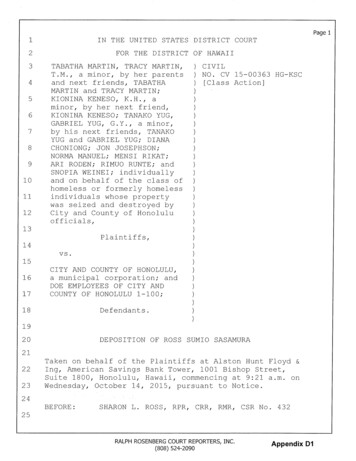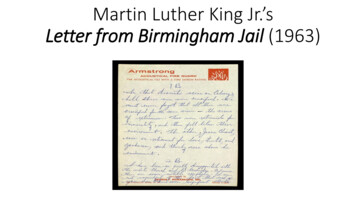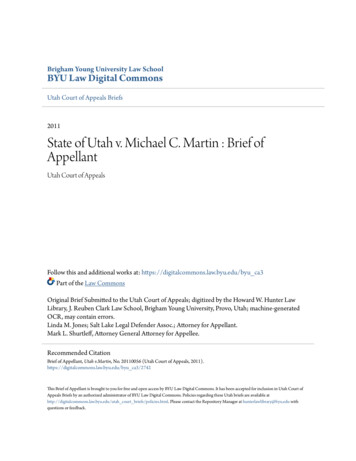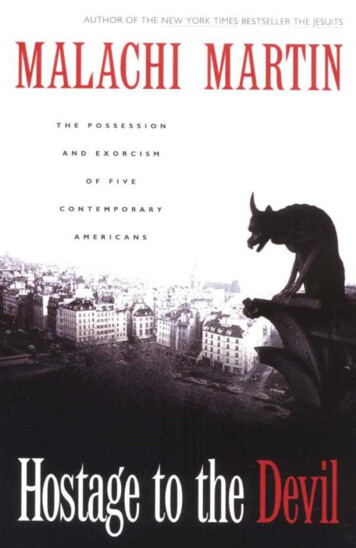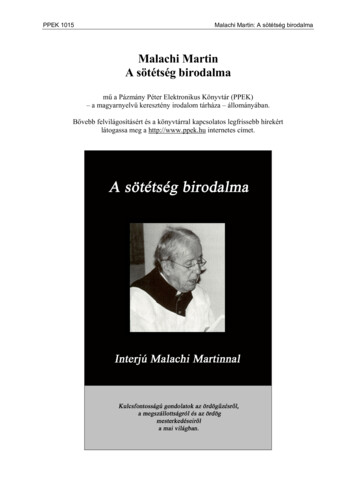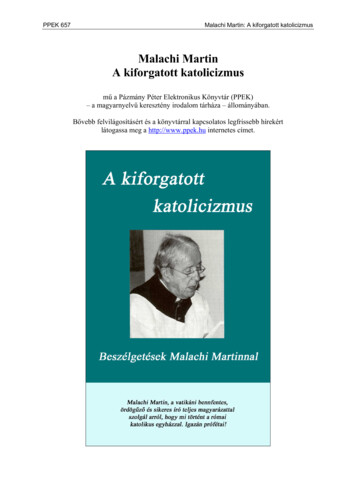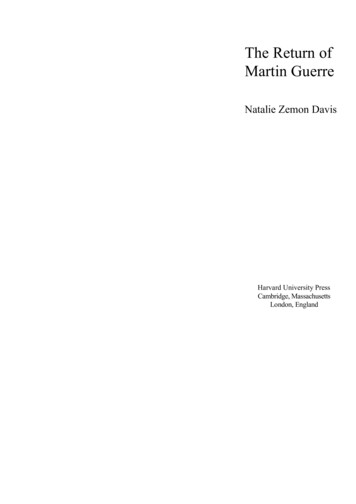
Transcription
The Return ofMartin GuerreNatalie Zemon DavisHarvard University PressCambridge, MassachusettsLondon, England
Copyright 1983 by the President and Fellowsof Harvard CollegeAll rights reservedPrinted in the United States of AmericaFor Chandler Davis20 19 18 17Library of Congress Cataloging in Publication DataDavis, Natalie Zemon, 1928-Thereturn of Martin Guerre.Bibliography: p.1. Du Tilh, Arnault, d. 1560.2. Guerre, Martin.3. Impostors and imposture—France.I. Title.LAW345.44'026383-277ISBN 0-674-76690-3 (cloth)344.405263ISBN 0-674-76691-1 (paper)Designed by Given Frankfeldt/
PrefaceTHIS BOOK GREW outof a historian's adventure with a differentway of telling about the past. The story of Martin Guerre hasbeen recounted many times. In the 1540s in Languedoc, a richpeasant leaves his wife, child, and property and is not heard fromfor years; he comes back—or so everyone thinks—but after threeor four years of agreeable marriage the wife says she has beentricked by an impostor and brings him to trial. The man almostpersuades the court he is Martin Guerre, when at the last momentthe true Martin Guerre appears. Two books were immediatelywritten about the case, one by a judge of the court. All overFrance there were comments on it, by the great Montaigneamong others. Over the centuries it was retold in books onfamous impostors and causes celebres, and is still remembered inthe Pyrenean village of Artigat where the events took place fourhundred years ago. It has inspired a play, two novels, and anoperetta.When I first read the judge's account I thought, "This mustbecome a film." Rarely does a historian find so perfect anarrative structure in the events of the past or one with suchdramatic popular appeal. By coincidence I learned that thescenarist Jean-Claude Carriere and the director Daniel
viiiPREFACEVigne were starting a screenplay on the same subject. I was ableto join them, and out of our collaboration came the film LeRetour de Martin Guerre.Paradoxically, the more I savored the creation of the film, themore my appetite was whetted for something beyond it. I wasprompted to dig deeper into the case, to make historical sense ofit. Writing for actors rather than readers raised new questionsabout the motivations of people in the sixteenth century—about,say, whether they cared as much about truth as about property.Watching Gerard Depardieu feel his way into the role of the falseMartin Guerre gave me new ways to think about theaccomplishment of the real impostor, Arnaud du Tilh. I felt I hadmy own historical laboratory, generating not proofs, buthistorical possibilities.At the same time, the film was departing from the historicalrecord, and I found this troubling. The Basque background of theGuerres was sacrificed; rural Protestantism was ignored; andespecially the double game of the wife and the judge's innercontradictions were softened. These changes may have helped togive the film the powerful simplicity that had allowed the MartinGuerre story to become a legend in the first place, but they alsomade it hard to explain what actually happened. Where was thereroom in this beautiful and compelling cinematographicrecreation of a village for the uncertainties, the "perhapses," the"may-have-beens," to which the historian has recourse when theevidence is inadequate or perplexing? Our film was an excitingsuspense story that kept the audience as unsure of the outcome asthe original villagers and judges had been. But where was thereroom to reflect upon the significance of identity in the sixteenthcentury?The film thus posed the problem of invention to the historianas surely as it was posed to the wife of Martin Guerre.AcknowledgmentsixI had to return to my original metier; even from location in thePyrenees I was running off to archives in Foix, Toulouse, andAuch. I would give this arresting tale its first full-scale historicaltreatment, using every scrap of paper left me by the past. I wouldfigure out why Martin Guerre left his village and where he went,how and why Arnaud du Tilh became an impostor, whether hefooled Bertrande de Rols, and why he failed to make it stick.This would tell us new things about sixteenth-century ruralsociety. I would follow the villagers through the criminal courtsand explain the judges' changing verdicts. And I would have therare opportunity to show an event from peasant life being reshaped into a story by men of letters.It turned out to be much more difficult than I had thought—butwhat a pleasure to recount the history of Martin Guerre onceagain.N.Z.D.PrincetonJanuary 1983A cknowledgmentsI am grateful to Princeton University and to the NationalEndowment for the Humanities for financial assistance inpreparing this book. I also want to thank the archivists and staffof the Archives Departementales of the Ariege, the HauteGaronne, the Gets, the Pyrenees-Atlantiques, the Gironde, andthe Pas-de-Calais for their advice and courtesy, which madepossible rapid progress in my research. Marie-Rose Belier, PaulDumons, and Hubert Daraud of Artigat
xAcknowledgmentswere willing to share with me their memories of their village andof the story of Martin Guerre. Jean-Claude Carriere and DanielVigne gave me new ways to think about the connections betweenthe "general trends" of historians and the living experience of thepeople. Emmanuel Le Roy La-durie provided importantencouragement when it was needed. Ideas and bibliographicalsuggestions were offered by numerous colleagues in the UnitedStates and France: Paul Alpers, Yves and Nicole Castan, BarbaraB. Davis, William A. Douglass, Daniel Fabre, StephenGreenblatt, Richard Helmholz, Paul Hiltpold, ElisabethLabrousse, Helen Nader, Laurie Nussdorfer, Jean-Pierre Poussou,Virginia Reinburg, and Ann Waltner. Alfred Soman was generous in his advice for the chapters on criminal justice. Theediting of Joyce Backman added much to the clarity of the thetext. Without the help of my authentic husband, Chandler Davis,this history of an impostor-spouse could never have existed.ContentsIntroduction;1 From Hendaye to Artigat62 The Discontented Peasant193 The Honor of Bertrande de Rols214 The Masks of Arnaud du Tilh355 The Invented Marriage426 Quarrels517 The Trial at Rieux628 The Trial at Toulouse139 The Return of Martin Guerre821011The StorytellerHistoire prodigieuse, Histoire tragique12Of the Lame94104114 Epilogue 123Select
IllustrationsFirst edition of Coras, Arrest Memorable (1561). BibliothequeNationale.xiiiFirst page of the Arrest Memorable (1561). Bibliotheque Mazarine,xivThe routes of Martin Guerre.9Whimsical soldiers, ca. 1545. Archives departemen tales del'Ariege, 5E6220.23Peasants dance. Bibliotheque Nationale, Cabinet des Estampes.29A rural couple. Bibliotheque Nationale.45Confrontation between accused and witness. Harvard LawSchool Library, Treasure Room.65First pictorial representation of the case. Bibliotheque Mazarine, Paris.87Jean de Coras. Bibliotheque Nationale, Cabinet des Estampes.WlA case of remarkable resemblance. University of Pennsylvania,Furness Memorial Library, Special Collections, Van Pelt Library,inPunishment arrives on a wooden leg. Princeton UniversityLibrary, Department of Rare Books and Special Collections.121
IntroductionFEMME BONNE qui a mauvais mary, a bien souvent le coeurmarry" (A good wife with a bad husband often has a sorry heart)."Amour peut moult, argent peut tout" (love may do much, butmoney more). These are some of the sayings by which peasantscharacterized marriage in sixteenth-century France. Historianshave been learning more and more about rural families frommarriage contracts and testaments, from parish records of birthsand deaths, and from accounts of courtship rituals and charivaris.But we still know rather little about the peasants' hopes and feelings; the ways in which they experienced the relation betweenhusband and wife, parent and child; the ways in which theyexperienced the constraints and possibilities in their lives. Weoften think of peasants as not having had much in the way ofchoices, but is this in fact true? Did individual villagers ever tryto fashion their lives in unusual and unexpected ways?But how do historians discover such things about anyone inthe past? We look at letters and diaries, autobiographies,memoirs, family histories. We look at literary sources—plays,lyric poems, and stories—which, whatever their relation to thereal lives of specific people, show us what sentiments andreactions authors considered plausible for a given pe-
2THE RETURN OF MARTIN GUERREriod. Now the peasants, more than ninety percent of whom couldnot write in the sixteenth century, have left us few documents ofself-revelation. The family histories and journals that have comedown to us from them are sparse: an entry or two on births anddeaths and the weather. Thomas Platter can give us a portrait ofhis hard-working peasant mother: "Except one time when we saidgood-bye to her, I never saw my mother cry; she was acourageous and virile woman, but rough." But this was writtenwhen that learned Hebraist had long since left his Swiss villageand mountain pastures behind him.As for literary sources on the peasants, where they exist, theyfollow the classical rules that make villagers a subject of comedy.Comedy is about "personnes populaires," people of low condition,so the theory went. "In a style humble and low, comedy representsthe private fortunes of men . . . Its issue is happy, pleasant, andagreeable." So in Les Cent Nouvelles Nouvelles (the fifteenthcentury collection of comic stones, several times reprinted in thesixteenth century), an acquisitive peasant comes upon his wifehaving sexual intercourse with a friend, is mollified in his rage bythe promise of twelve measures of grain, and then to keep the bargain has to let the lovers finish up. In the Propos Rustiques,published by the Breton lawyer Noel du Fail in 1547, the oldpeasant Lubin reminisces about when he got married at the age ofthirty-four: "I hardly knew what it was to be in love . butnowadays there is hardly a young man past fifteen who hasn't triedsomething out with the girls."4 The image of peasant feeling andbehavior that emerges from such accounts is not without its value—comedy is, after all, an important way to explore the humancondition—but it is limited in its psychological register and in therange of "situations in which villagers are placed.Introduction3But there exists another set of sources in which peasants arefound in many predicaments and in which the ending is notalways happy: the records of different court jurisdictions. It is tothe registers of the Inquisition that we owe Emmanuel Le RoyLadurie's picture of the Cathar village of Montaillou and CarloGinzburg's study of the daring miller Menocchio. The records ofdiocesan courts are full of marriage cases, which historians havebeen using to understand how villagers and cityfolk maneuveredwithin the tight world of custom and law to find a suitable mate.And then there are the records of various criminal jurisdictions. Here, for instance, is the story told in 1535 to the kingby a young Lyonnais villager who was trying to win a pardon foran impulsive murder. Even allowing for the phrases urged uponhim by his attorney or notary, we have a portrait of an unhappymarriage:About a year ago the said suppliant, having found a partner with a gooddowry, married Ancely Learin and since then supported her honestly ashis wife and sought to live with her in peace. But the said Ancely,without rhyme or reason, took it into her head to kill him, and in factbeat him and threw stones at him . . . The suppliant accepted thispeaceably, thinking things would calm down after a time . . . But thenone Sunday earlier this month of May, he was quietly eating with herand asked her for a drink of wine. She said she would give it to him inthe head, threw the bottle at him and spilled wine all over his face . . .Then in her fury, she picked up a tureen and would have wounded thesuppliant seriously if the servant-girl had not put herself between them . . Being very excited, he picked up a bread knife, ran after the saidAncely and stuck it in her stomach.The wife did not live long enough to tell her side of the story.
4THE RETURN OF MARTIN GUERREFrom such documents we learn of peasant expectations andfeelings at a time of sudden agitation or crisis. In 1560, however,there came before the Parlement of Toulouse a criminal case thatrevealed peasant marriages over many years, a case soextraordinary that one of the men who judged it published a bookabout it. His name was Jean de Coras, a native of the region,distinguished doctor of laws, author of Latin commentaries on thecivil and canon law and humanist. Coras's Arrest Memorablesummed up all the evidence, formal arguments, and judgments inthe case and included his annotations upon them. It was not acomedy, he said, but a tragedy, even though the actors wererustics, "people of low condition." Written in French, the bookwas reprinted five times in the next six years and had severalmore editions in French and Latin before the end of the century.Combining features of a legal text and a literary tale, Coras'sbook on the case of Martin Guerre leads us into the hidden worldof peasant sentiment and aspiration. That it is an unusual caseserves me well, for a remarkable dispute can sometimes uncovermotivations and values that are lost in the welter of the everyday.My hope is to show that the adventures of three young villagers arenot too many steps beyond the more common experience of theirneighbors, that an impostor's fabrication has links with moreordinary ways of creating personal identity. I also want to explainwhy a story that seemed fit for a mere popular pamphlet—and indeed was told in that form—became in addition the subject for ajudge's "one hundred and eleven beautiful annotations"; and tosuggest why we have here a rare identification between the fate ofpeasants and -the fate of the rich and learned.For sources I start with Coras's Arrest of 1561 and the shortHistoria of Guillaume Le Sueur, published the sameIntroduction5year. The latter is an independent text, dedicated to another judgein the case; in at least two instances, it has material not found inCoras but which I have verified in archival sources. I use LeSueur and Coras to supplement each other, though in the fewplaces where they are in conflict I give greater weight to thejudge. In the absence of the full testimony from the trial (all suchrecords for criminal cases before 1600 are missing for theParlement of Toulouse), I have worked through the registers ofParlementary sentences to find out more about the affair andabout the practice and attitudes of the judges. In pursuit of myrural actors, I have searched through notarial contracts in villagesall over the dioceses of Rieux and Lombez. When I could not findmy individual man or woman in Hendaye, in Arti-gat, in Sajas, orin Burgos, then I did my best through other sources from theperiod and place to discover the world they would have seen andthe reactions they might have had. What I offer you here is in partmy invention, but held tightly in check by the voices of the past.1
From Hendaye to ArtigatI FromHendayeto ArtigatIN 1527 the peasant Sanxi Daguerre, his wife, his young sonMartin, and his brother Pierre left the family property in theFrench Basque country and moved to a village in the county ofFoix, a three-week walk away.It was not the most usual thing for a Basque to do. Not that themen of Labourd were stay-at-homes, but when they traveled itwas more likely out to sea, to trap whales on the Atlantic, even asfar as Labrador. When they left for good, they were more likely tocross the Bidassoa River into the Spanish Basque country ordown into Spain, rather than turn inland north of the Pyrenees.And the men who moved away were usually not heir to theirfamily's property, as was Sanxi Daguerre, but younger brotherswho could not or would not remain in the ancestral household. Soimportant were these family houses to Basque villagers that eachwas given a name which the heir and his wife assumed: "Theycall themselves Lords and Ladies of such-and-such a house, evenif it is only a pigpen," a hostile observer was to claim later on.Sanxi Daguerre's house was no pigpen, however. It waslocated in Hendaye, right on the border between France andSpain, a village of few houses, according to a traveler in71528, but with extensive common lands. Living between themountains, the river, and the ocean, the villagers herded sheep,fished, and farmed. The clay soil was not much good for grainsother than millet, but was excellent for apple trees; the Daguerrebrothers used the clay to develop a sideline in tilemaking. Life wasnot easy in the Labourd, but it had its strong points, at least in theeyes of some visitors: they note the beauty of the villages; thewonder and danger of the offshore whale hunt and the dividing ofthe catch; the men, women, and children playing in thewaves. "Throughout this country, the people are gay . . . they arealways laughing, joking and dancing, women and men both,"went one comment in 1528.2Nevertheless, Sanxi Daguerre decided to leave. Perhaps it wasthe continual threat of warfare in the region; the Basquecountry and Navarre were long sources of dispute betweenFrance and Spain, and the conflicts between Franqois I andthe emperor Charles V had their consequences for this frontierarea. In 1523 the imperial troops swept through Hendaye andravaged the Labourd; in 1524 the plague hit especially hard; in1525 Sanxi's first child Martin was born. Perhaps it wassomething personal, a quarrel between Sanxi and his father, thesenior "lord of the household" (the senior echekojaun, as he wascalled in Basque), if he were still alive, or with some other person.Perhaps Martin's mother had urged the move, for the Basquewomen were said to be forward, making knowntheir wants.Whatever the cause, Sanxi packed up his belongings anddeparted with his family and his younger unmarried brother. Theancestral property would remain in Hendaye, and one day Martinwould inherit it. Sanxi could not have sold it easily even if hehad wanted to, for the Fors—that is,
8THE RETURN OF MARTIN GUERREthe customs of the Laboured—prohibited the alienation ofpatrimonial goods except in cases of dire necessity and then onlywith the consent of other interested kin. He was free to disposeof his acquets—whatever he had acquired by his own industry—and Sanxi took with him enough resources to get himself wellestablished in his new village.The roads the family traveled on its trek east were busy ones.They crossed a region of age-old trade exchange between thePyrenees and the plains, its economy now quickening asToulouse intensified its role as a major center of redistribution.5Between the Save River and the Ariege River, the boundariesthat would be important in their new life, moved carts of pastelballs, on their way to the Toulouse dyeing shops; fleece, woolensrough and fine, wood, grain, wine, and fruit. The Daguerreswould have seen merchants and peddlers going to local fairs andmarkets; herdsmen taking sheep and cznle up to the mountainsfor the summer or down as far as the plains of Toulouse and Pamiers for the winter; pilgrims finding their way to the stillpopular shrine of Saint James of Compostela; and the young menleaving their villages behind them for the streets of Toulouse andelsewhere. At last the family stopped at Artigat, a village locatedin the large plain below the foothills of the Pyrenees, a few hours'ride by horse from Pamiers.Artigat stretched out on either side of the Leze, a small rivercompared to the Ariege to the east and the Garonne to the west,but still turbulent enough to overflow its banks from time to timeand devastate the peasants' lands. On these lands and on the hillsjust above them lived some sixty or seventy families, growingthe millet well known to Sanxi and Pierre Daguerre but alsowheat, oats, and grape vines, and pasturing cows, goats, andespecially sheep. A few
10THE RETURN OF MARTIN GUERREartisans worked in Artigat—a blacksmith, a miller, a shoemaker,and a dressmaker; perhaps there was some weaving as theresurely was at the nearby burg of Le Fossat. Market days wereheld from time to time and members of the Ban-quels familyeven referred to themselves as "merchants," but the medievalfairs at Artigat were gone and most local commerce now went onat Le Fossat. Artigat did have a resident notary by 1562, andperhaps earlier, but in any case a notary from Le Fossat made therounds to write down contracts in the village houses.The economic link of Artigat with nearby villages and burgs wouldhave been apparent to the Daguerres at once. Most important was theback-and-forth among Artigat and the village of Pailhes justupstream, Le Fossat just downstream, and the burg of Le Carla up ona hill to the west. Exchange could also take one down the Leze as faras Saint-Ybars, east over to the city of Pamiers, and back toward thePyrenees to Le Mas-d'Azil. Jean Banquels of Artigat rents a mare forsix years to a peasant from Pailhes. A merchant from Le Fossat rentsoxen to two farmers from Le Carla, who will pay him with grain laterat the September fair in Pamiers. Jehannot Drot of Artigat goes to LeFossat every winter to contract for the sale of the fleece from hisSpanish sheep; he is paid at once and will return with the wool inMay. Others sell their fleece to merchants in Pamiers. A shepherdfrom Le Carla makes an agreement of gasailhe (as it is called in thelangue d'oc) with a merchant of Saint-Ybars: he is granted thirtyewes, which he will feed and pasture at his expense; merchant andshepherd will share the cost of his taking them "up to the mountain"and will split the profits half and half. James Loze of Pailhes has apartnership with a merchant of Pamiers for fifty-two ewes; they 1share expenses and profits, wool going to Pamiers after shearing andsalt going to Pailhes. Grains and wines moveFrom Hendaye to Artigat11also, either in the form of rents paid in kind or as purchases madeby peasants at Le Fossat and Pamiers.7Such a busy little world could not have seemed totally alien tothe Daguerres, for there was also exchange among villages andburgs in the Labourd. What was really different from the Basquecountry was the way the land moved, both in inheritance and insales. Here in the plain below the Pyrenees there was very littleeffort among the common people to hold the family propertytogether. The testaments in the area around Artigat rarely benefitone child but instead provide dowries for the daughters anddivide the inheritance equally among the sons, even if there arefive of them. (If there are only daughters, the property is dividedequally among them.) Sometimes two brothers or brothers-in-lawthen decide to farm together; sometimes a brother leaves thevillage and bequeaths his portion to another heir; most often (aswe can see by the land register, the terrier, of Artigat in theseventeenth century) the heirs divide the land and live near oneanother. When a household is set up with two generations ofmarried folk, it is not the Basque combination of the old heir andthe young heir, but a widowed parent, usually the mother, withone of her married children.In this situation a piece of inherited property can be sold withmuch less hindrance than in the Labourd. So a priest of Le Fossatsells a garden to a merchant, explaining he has had to support hisold parents for the past eight years. So Antoine Basle of Artigatsells for a modest 35 livres "the fourth part of the goods andsuccession of late Jacques Basle his father" to a man from anearby hamlet, and the brothers Caldeyro sell six seterees of theirland (a little under three acres) to the brothers Grose of Le Masd'Azil, who are taking up residence in Artigat.That inherited property (les propres) was sold from time
12THE RETURN OF MARTIN GUERREto time did not mean that the peasants along the Leze River werenot attached to their lands. Whole sections of the jurisdiction ofArtigat had designations that were also family names: "LesBanquels," not far from the village center; "Rols" to the west;"Le Fustie" near the Leze, where the miller Fustie lived. Plowedfields had names, too, as did vineyards and meadows—"a laplac," "al sobe," "les asempres," "al cathala," "la bardasse"—andpeasants who aquired them sometimes took these titles as analias.10Of course the identification between family and land waslimited at Artigat, probably more than it had been at Hen-daye,by the social and economic structure of the village. At its topwere affluent families, like the Banquels and after them the Rols,who had many parcels of property scattered throughout Artigat,some of which they farmed themselves and some rented out toother families for fixed payments or a share of the crop. Thesewere the men who collected the revenues from the churchbenefices within Artigat, buying that right every year from thebishop of Rieux, and who directed the parish confraternity at thevillage church. They hobnobbed with the best families outsidethe world of the seigniors: the Loze of Pailhes; the Boeri, ruraltraders and shoemakers of Le Fossat; the Du Fau, notaries atSaint-Ybars. In contrast to this village elite we come across Bernard Bertrand and his wife, who have an inadequate sixteenseterees of land to support themselves and six children; theshepherd Jehannot Drot, who has to borrow wine and grainswhen times are hard; and the Faure brothers, sharecroppers whoare so far behind in their payments that they are brought to courtby their proprietor.None of the inhabitants of Artigat paid manorial dues or owedmanorial services to a seignior, however. Whatever lands theyhad, they held free and allodial, a fact of whichFrom Hendaye to Artigat13they were very proud. For at least a hundred years there had beenno noble properties in the village; a certain Jean d'Escornebeuf,seignior of Lanoux just to the west of Artigat, was buying landsthere after the Daguerres' arrival, but he had to pay taille on them,just like any peasant. All the administration in the village belongedeither to the community itself or to the king, represented in the firstinstance by his judge at Rieux, a town several hours' ride away, bythe senechal of Toulouse, and on appeal by the Parlement ofToulouse. On the lowest level were three or four consuls ofArtigat, local worthies approved annually by the judge of Rieux towear the red and white hoods of village office. They hadjurisdiction over agricultural matters, such as the common lands(rather small in extent in Artigat) and the date for starting thewinter harvest; wardships, inventories, and auctions of goods postmortem; complaints of false weights and measures; and disruptionof public order by blasphemy and petty assaults. From time to timethey called assemblies of the male inhabitants.1All of this must have appealed to the Daguerres, who hadgrown up in an area where (despite the growing power of the"noble" Urtubies) the seigniorial regime had been weak andwhere all parishoners had the freedom to meet whenever theywished to draw up statutes for their common needs. If the familyhad settled just upstream at Pailhes, where the Villemurs,seigniors of Pailhes and captains of the Chateau de Foix, had theircastle, it would have been a different story.13 The case of MartinGuerre might never have run its course if a resident seignior or hisagents had had the authority to intervene. As it was, the Artigatoishad to deal much of the time only with the gossip and pressure oftheirpeers.Apart from its distinctive freedoms, Artigat had a rather
14THE RETURN OF MARTIN GUERREfluid, mixed identity. Linguistically, it was right on the borderbetween the differing nasals and liquid sounds of Gascon andlangue d'oc. Geographically, it was within the county of Foix,but together with Pailhes and some other villages it fell under thegovernment of Languedoc. Though near Pamiers, the seat of thediocese of Pamiers, Artigat was part of the diocese of the moredistant Rieux. The rector of the main parish church, Saint-Serninof Artigat, was named by the canons of Saint-Etienne, evenfarther away in Toulouse; the curate of Bajou, a smaller parishthat fell within the jurisdiction of Artigat, was also put in place bya chapter in Toulouse. The men of Artigat might move acrossseveral boundaries in the course of their activities as farmers,shepherds, litigants, and Christians, and people called them different things; Gascons, "Foixiens," Languedociens.14Into this village, then, came the Daguerres, settling to the eastof the Leze, acquiring land (perhaps buying someoneelse'spropres), and establishing a tileworks as they had atHendaye. The brothers had a joint household, for a time anyway,and they prospered—"they became rather comfortable for peopleof small estate," as the pamphleteer Guil-laume Le Sueur said ofthem later. Their holdings increased on the hills up towardBajou, and along with their tiles and bricks, there was nowwheat, millet, vines, and sheep.15To be accepted by the village they had to take on someLanguedoc ways. Daguerre became Guerre; if Pierre had usedthe Basque form of his name, Betrisantz or even Petri, he nowchanged it. Sanxi's wife probably continued to carry baskets ofgrain on her head, but she restitched her headdress and thedecorations on her skirt so as to fit in with her neighbors. At theparish mass, she would have to get used to the fact that herewomen did not push ahead of the men to make their offerings,did not go about theFrom Hendaye to Artigat15church to collect for the vestry, and did not serve as sacristans.And all of them would have become more fluent in the langued'oc and become accustomed to a world where the written wordwas used more frequently than at Hendaye. "The language of theBasques," wrote Judge de Coras, "is so obscure and difficult thatmany have thought that it
preparingthis book.I alsowant tothankthe archivists andstaff of the Archives Departementales of the Ariege, the Haute-Garonne,the Gets,the Pyrenees-Atlantiques,the Gironde,and the Pas-de-Calais for their advice andcourtesy,whichmade possible rapidprogress inmy research.Ma
